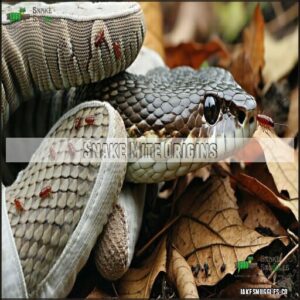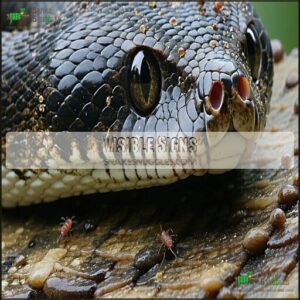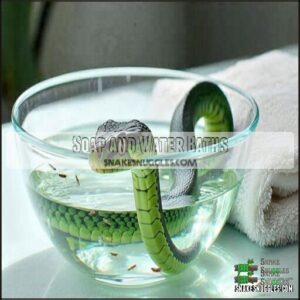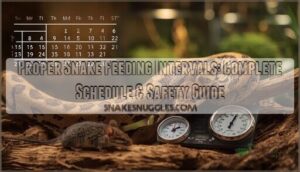This site is supported by our readers. We may earn a commission, at no cost to you, if you purchase through links.

They often hitch a ride into enclosures on wild-caught snakes, contaminated decor, or even your clothing.
You might notice your snake soaking excessively, acting restless, or showing small black dots on its skin—those are mite infestations, which can be treated with safe treatments like mite sprays or Provent-A-Mite.
Treating snake mites usually involves cleaning the enclosure, bathing your snake, and using these treatments.
Prevention is key: quarantine new snakes, clean enclosures regularly, and monitor closely.
Want peace of mind? A solid prevention plan keeps mites out for good.
Table Of Contents
- Key Takeaways
- What Are Snake Mites
- Snake Mite Origins
- Identifying Snake Mites
- Snake Mite Treatment
- Snake Mite Prevention
- Eradicating Snake Mites
- Frequently Asked Questions (FAQs)
- How do you know if you have snake mites?
- How long do snake mites last?
- How do you get rid of snake mites?
- Can humans get snake mites?
- What will eat snake mites?
- How Long Does It Take for Snake Mites to Reproduce?
- How Often Should I Check for Snake Mites?
- What Other Animals Are at Risk of Snake Mite Infestation?
- How Long Should I Quarantine a New Reptile?
- Is There a Way to Prevent Snake Mites From Returning?
- Conclusion
Key Takeaways
- Check your snake and its enclosure regularly for mite infestations, focusing on tiny black or red dots, ash-like residue, and unusual snake behavior like soaking or rubbing.
- Prevent reptile infestations by keeping enclosures clean, quarantining new reptiles for 30 days, and maintaining strict hygiene when handling snakes or enclosure materials.
- Get rid of snake mites by treating your snake with soapy baths or mite sprays, deep cleaning the enclosure with disinfectant, and replacing porous materials.
- Act fast when you spot mites since they reproduce quickly in warm, humid conditions, completing their life cycle in just 13–19 days.
What Are Snake Mites
Snake mites are tiny parasitic insects that feed on the blood of snakes and other reptiles.
Tiny and relentless, snake mites thrive on reptiles’ blood, causing irritation, anemia, and significant health challenges if left unchecked.
These pests are oval-shaped, barely visible to the naked eye, and can quickly infest enclosures under the right conditions, which makes them tiny parasitic insects a significant concern.
Snake Mite Biology
Understanding snake mite biology helps tackle infestations.
These oval-shaped mites feed on reptile blood, causing irritation and anemia.
Their small size makes detection tricky.
They thrive in warm, humid conditions with:
- High reproduction rates—eggs hatch within a day.
- Their behavior—mites hide in cracks after feeding.
- Their morphology—adapted for crawling and puncturing skin.
Keeping environments clean reduces their impact on snake health.
Life Cycle of Snake Mites
The snake mite lifecycle has five stages: egg, larva, protonymph, deutonymph, and adult. It’s quick—completed in 13-19 days—with typical lifespans of 10 days.
Warm, humid environments boost reproduction. Mites can lead to anemia from blood loss from feeding on the snake’s blood, as explained in the article about anemia from blood loss.
| Stage | Duration | Key Feature |
|---|---|---|
| Eggs | 1-4 days | Hatch under ideal conditions |
| Larva | 1-2 days | Non-feeding, inactive stage |
| Nymph Stages | 7-12 days | Hungry for blood, rapid growth |
Monitoring conditions can disrupt mite eggs and prevent infestations. This is crucial for maintaining the health of the snake, as mite infestations can have severe consequences, including blood loss.
Snake Mite Species
Ophionyssus natricis is the primary mite species affecting snakes, thriving on their blood.
These mites aren’t picky, often infesting other reptiles too. Tiny and oval-shaped, they live within enclosures under warm, humid conditions.
Mite identification is key since species variation exists. Their behavior, from hiding in scales to clustering near eyes, highlights their adaptability and host specificity.
Snake Mite Origins
Snake mites often come from wild-caught snakes, poor hygiene, or contaminated supplies. They can also spread through direct contact, shared enclosures, or even hitching a ride on your hands.
Snake mites thrive through poor hygiene, wild-caught snakes, or hidden hitchhikers—quick action and cleanliness are your best defenses.
Wild-Caught Snakes
Wild-caught snakes often bring uninvited guests like mites due to their high parasite load and lack of natural immunity.
These reptiles face acclimation stress, which can worsen infestations.
- Infested snakes from the wild lack prior treatment or prevention.
- Handling or housing without quarantine spreads mites rapidly.
- Ethical concerns about wild harvesting impact both conservation and pet health outcomes, raising issues of acclimation stress.
Cross Contamination
Cross-contamination spreads snake mites quickly between enclosures or reptiles.
Indirect transmission happens when you move mites on your hands, tools, or clothes.
Quarantine any new snakes and practice strict hygiene protocols like washing hands and disinfecting equipment.
Enclosure isolation and source tracking help locate infestations.
Prioritize mite prevention with proper snake hygiene and regular inspections to break the cycle.
Unhygienic Living Conditions
A dirty enclosure invites snake mites.
Waste buildup, poor water quality, and neglecting cleaning frequency create perfect breeding grounds for a mite infestation.
High humidity without proper control worsens the problem.
Regular enclosure cleaning and maintaining good snake hygiene are key.
Verify the enclosure size supports movement, and always check for missed debris to keep your snake healthy and safe.
Substrate and Enclosure Decor
Bioactive substrates and naturalistic decor might look great, but they can harbor snake mites if not cleaned properly.
Enclosure hygiene is key. Always inspect and maintain decor regularly to stay ahead of infestations.
- Replace substrate types like wood chips if they seem infested.
- Sterilize hiding spots and decorations.
- Make enclosure cleaning a weekly habit for protection.
Human Carriers
Sometimes, it’s your own hands or clothes that allow mite transmission to sneak into your snake’s enclosure.
Accidental spread often comes from handling infested snakes or gear. Mite exposure on clothing contamination is easy to miss.
Good hygiene practices, like washing hands and changing clothes, can stop mites in their tracks. Visitor protocols also limit risks from human carriers.
Regular enclosure cleaning helps prevent infestations.
Identifying Snake Mites
You can identify snake mites by looking for tiny black, red, or gray dots moving on your snake’s body or in its enclosure.
Watch for signs like itching, soaking, or unusual behavior, which often point to a mite problem.
Physical Description
Snake mites are tiny, oval-shaped pests, measuring about 0.5 to 1 millimeter.
Their color ranges from tan to dark brown, depending on their life stage and whether they’ve fed.
These bugs look like moving specks of dirt, with visible legs under a microscope.
Their small size makes them hard to spot, especially in corners or crevices of the snake’s habitat.
Behavioral Symptoms
When dealing with a mite infestation, watch for behavioral changes like skin rubbing, prolonged soaking, irritability, and appetite loss.
These signs indicate your snake’s discomfort. Lethargy shows stress or blood loss from the mites.
Snake behavior may seem off—rubbing against objects is common as they try to ease itching.
Acting quickly prevents further harm to your snake, and it is crucial to address the issue promptly to avoid further harm.
Visible Signs
You might notice tiny dots moving on your snake—black, red, or gray.
These are snake mites, often clustered near the eyes, nostrils, or gular fold, their favorite feeding locations.
Skin abnormalities like scaly patches and shedding issues can appear.
Mite infestation symptoms also include ash-like droppings on scales, which signal trouble needing attention.
Detection Methods
Spotting snake mites can feel tricky, but solid detection methods help.
Start with a visual inspection around snake eyes, skin folds, and the water bowl for moving specks.
Try tape tests on snake skin to catch mites or their droppings.
Check for ash-like residue around shed skin.
These signs confirm a mite infestation before symptoms worsen.
Snake Mite Treatment
To treat snake mites, you’ll need to act quickly and follow a structured approach. Using sprays, baths, and thorough enclosure cleaning can eliminate the infestation effectively.
Choose a Spray Solution
Choosing the right spray solution for snake mites is essential. Look into natural options for immediate contact-kill benefits.
Understand Ivermectin safety—use cautiously to avoid risks. Be mindful of Fipronil concerns, like avoiding sensitive areas during application.
Follow proper application methods for effective coverage. Many keepers find success using specialized mite treatments.
Spray solutions help tackle mite infestations, but overuse can cause resistance risks, so use them strategically for mite treatment.
Ivermectin and Fipronil
Treating snake mites effectively involves antiparasitic drugs like Ivermectin and Fipronil.
Ivermectin dosage must be precise, as it’s toxic to some reptiles. Fipronil toxicity is lower but still requires care.
Both disrupt mite nervous systems differently, tackling resistance concerns.
- Ivermectin: Topical or injectable, but risky.
- Fipronil: Safer for most snakes.
- Combo therapy: Boosts effectiveness, reduces mite survival.
Soap and Water Baths
A soap and water bath can help remove snake mites safely. Use mild soap concentration mixed with warm water (75–85°F).
Let your snake soak for 15–20 minutes, ensuring the water level allows easy breathing. Gently rub its body to dislodge mites.
Post-bath care includes drying your snake with a soft towel and cleaning its enclosure thoroughly. Poor hygiene can contribute to mite infestations, and it is crucial to maintain a clean environment to prevent mite infestations.
Repeat daily if needed, and for more information on treatment and home remedies, visit Poor hygiene.
Provent-A-Mite
After baths, Provent-A-Mite takes snake mite treatment up a notch.
It’s effective for mite control in enclosures, but not applied directly on snakes.
Follow label instructions carefully to address safety concerns.
Provent-A-Mite offers long-term effects, though resistance development may occur with overuse.
Alternative products exist, but it’s a trusted choice for managing mite infestations in reptiles, providing a solution for mite control.
Snake Mite Prevention
Preventing snake mites starts with clean enclosures, proper hygiene, and careful monitoring. By quarantining new snakes and using tools like Provent-A-Mite, you can reduce infestation risks substantially.
Regular Cleaning
Keeping a clean enclosure is key to avoiding snake mites.
Regularly remove waste and leftover food, and change water daily to prevent stagnant conditions. Disinfect surfaces and clean equipment like hides and water bowls weekly.
Using the right snake habitat products can further aid in maintaining a healthy environment.
Consistent enclosure sanitation and these preventative measures support snake care as well as help with mite control, reducing infestation risks effectively.
Quarantining New Snakes
Quarantining new snakes stops infestations before they spread. Always isolate new arrivals for at least 30 days.
Follow these key steps:
- Place them in a separate enclosure (Isolation Location) during this snake quarantine period.
- Monitor daily for mites and unusual behavior (Monitoring Protocols).
- Use Preventative Treatments like mite sprays early.
Gradual introduction reduces cross-contamination risks dramatically, and this approach is crucial for the health of the snakes, making quarantine a necessary step.
Practicing Good Hygiene
Good hygiene is your strongest line of defense against snake mites.
Wash your hands before and after handling snakes. Sanitize enclosures regularly, dispose of waste properly, and inspect for mites during routine checks.
Use clean equipment for snake cleaning and follow strict enclosure sanitation. These simple mite prevention strategies create a safer, healthier environment for your reptile.
| Steps | Why It Matters | Consequences of Neglect |
|---|---|---|
| Hand Washing | Prevents mite transfer | Cross-contamination |
| Enclosure Sanitation | Reduces mite habitats | Persistent infestations |
| Proper Disposal | Removes mite eggs | Explosive outbreaks |
| Routine Checks | Spots mites early | Delayed treatment risks |
| Clean Equipment | Prevents reintroductions | Reinfection cycles |
Using Provent-A-Mite
After cleaning, consider Provent-A-Mite for snake mite treatment. This spray offers long-term effects but requires careful use.
Here’s how:
- Remove animals from the enclosure.
- Spray surfaces evenly, avoiding direct snake contact.
- Let treated areas dry completely.
- Monitor for resistance concerns over time.
- Explore alternative products if mites persist.
Provent-A-Mite guarantees safer, easier mite eradication.
Eradicating Snake Mites
To eradicate snake mites, focus on thoroughly cleaning the enclosure and treating your snake with effective solutions.
Replace contaminated substrate, disinfect all surfaces, and monitor the snake closely to prevent reinfestation, which is crucial for the snake’s health and to avoid reinfestation.
Deep Cleaning Enclosures
Deep cleaning your snake’s enclosure starts with removing all items.
Dispose of porous materials prone to mites. Use a bleach solution ratio of 1:30 for sanitization. Scrub surfaces with safe cleaning products and a sponge, letting the bleach sit for ten minutes.
To maintain a healthy habitat, schedule deep cleanings weekly or monthly.
Vacuuming techniques guarantee no mites or eggs remain. Boil enclosure rocks for thorough sterilization before reassembling.
Disinfecting and Replacing Substrate
Start by safely handling substrate disposal, removing all porous items and enclosure decor.
Clean thoroughly using a bleach solution (1:30 bleach concentration), letting it sit for 10 minutes before rinsing.
Boil rocks to kill mites, then replace the substrate with paper towels for easy monitoring.
For maximum hygiene, consider using a specialized enclosure cleaner.
Deep cleaning guarantees effective sanitization, giving your snake a fresh, mite-free start.
Soliciting Veterinary Help
If cleaning hasn’t worked or your snake is sluggish, it’s time to call a reptile vet.
A snake vet can offer medication options like ivermectin injections or mite sprays, guaranteeing treatment is safe.
Look for a reptile specialist when choosing vets.
Don’t skip follow-up care—mites can return quickly without complete eradication.
Veterinarian treatment guarantees better outcomes.
Ongoing Protection and Monitoring
To keep mite-free snakes, stay vigilant with regular inspections.
Place mite traps in enclosures as an early warning system. Use preventative treatments and maintain proper environmental control by monitoring temperature and humidity.
Practice strict snake quarantine and cross-contamination prevention when introducing new pets. Verify snake enclosure hygiene by cleaning routinely.
These steps help stop mite infestation prevention before it starts, ensuring proper environmental control and promoting snake quarantine.
Frequently Asked Questions (FAQs)
How do you know if you have snake mites?
You’ll notice tiny black, red, or gray dots moving on your snake or in its water bowl.
Your snake might soak excessively, rub against objects, or appear sluggish.
Dust-like droppings can indicate their presence.
How long do snake mites last?
Snake mites live around 10 days but they breed quickly, completing their life cycle in just 13-19 days under warm, humid conditions.
If untreated, infestations stick around, making fast action essential to control them.
How do you get rid of snake mites?
To get rid of snake mites, clean the enclosure thoroughly with a bleach solution, replace the substrate.
Treat your snake with mite sprays or soapy baths.
Repeat treatments and monitor regularly to confirm elimination.
Can humans get snake mites?
Funny enough, you don’t need to worry.
Snake mites are species-specific parasites. They’ll happily feed on reptiles, but they won’t infest you or other pets.
Still, clean thoroughly to avoid accidental spread between enclosures, as this is a key step to prevent accidental spread.
What will eat snake mites?
Tiny predatory mites like Hypoaspis miles can help control snake mites.
They’re harmless to reptiles but effective in reducing infestations by preying on snake mites and their eggs.
These beneficial mites hunt and eat pest mites.
How Long Does It Take for Snake Mites to Reproduce?
In just 13 to 19 days, these pests can complete their life cycle, turning eggs into adults.
With the right warm, humid conditions, they reproduce quickly, making infestations feel like they multiply overnight!
How Often Should I Check for Snake Mites?
You should check for snake mites weekly, especially after adding new reptiles or changing enclosures.
Look for tiny moving dots, ash-like dust, or abnormal behavior like soaking and rubbing to catch infestations early.
What Other Animals Are at Risk of Snake Mite Infestation?
Snake mites primarily infect reptiles like lizards, turtles, and geckos, alongside snakes.
They don’t target mammals, birds, or humans, but they can hitch a ride on you and spread between reptile enclosures.
How Long Should I Quarantine a New Reptile?
Quarantine new reptiles for at least 30 days.
This gives time to spot illnesses or unseen parasites. Watch for mites, unusual shedding, or behavioral changes.
A clean, simple setup helps you monitor them easily, which is crucial during the quarantine period to ensure the health and well-being of the reptiles.
Is There a Way to Prevent Snake Mites From Returning?
Keep enclosures clean and inspect new snakes before adding them.
Use mite-proof substrates, avoid cross-contamination with other reptiles, and maintain hygiene.
Regularly clean tools, hands, and decor to stop mites from hitching a ride back, which is crucial for preventing the spread of mites.
Conclusion
Dealing with snake mites might seem overwhelming at first, but the right approach makes all the difference.
These persistent pests thrive in neglected conditions, so focus on prevention through proper hygiene, regular cleaning, and quarantining new arrivals.
If mites strike, act quickly—clean thoroughly, treat your snake, and eliminate their hiding spots.
Remember, vigilance is key, and with a little effort, you can keep snake mites at bay by monitoring your snake and its habitat to stop infestations before they start.


















